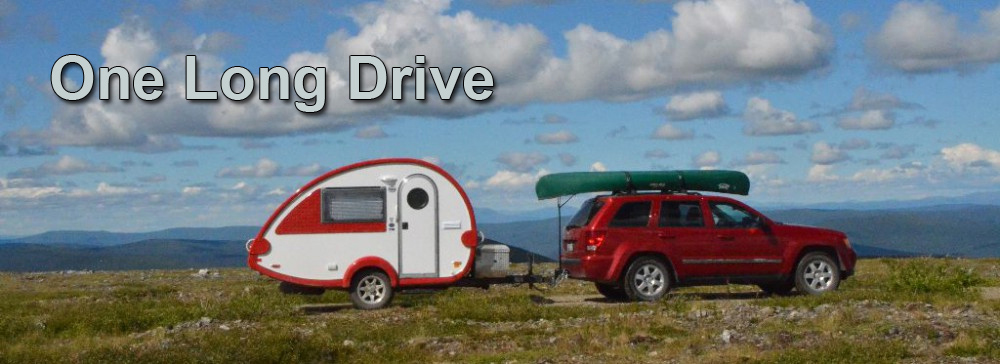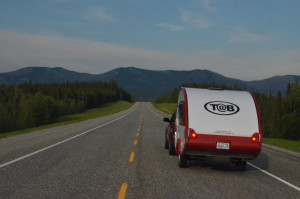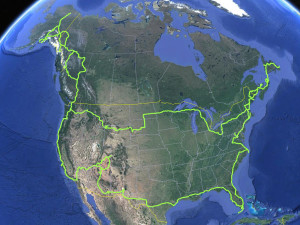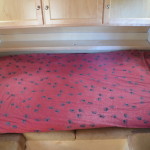This post is about my portable CPAP kit and is in response to some of the conversations I’ve had about taking my CPAP beyond the trailer. I have used a CPAP machine to keep my breathing normal at night for over 15 years. During that time I’ve also enjoyed plenty of backwoods adventures beyond where a trailer can go. On these adventures sleeping well is even more important than back home.
With respect to just dry camping in the trailer I should always have power. I have two group 24 batteries for storage and 200 watts of solar panels on the roof. I also have a generator for that odd situation where I might be off grid for a long time and deep in a forest, or during winter in the north. Even so, I always have my portable kit ready to go as a backup, and worst case the CPAP can run from the car battery.
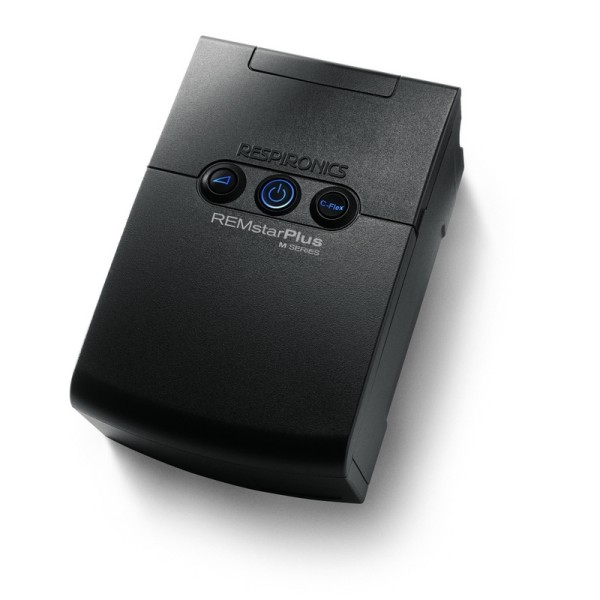 This kit has been on extended backpacking, canoe, kayak and rafting trips. Long trips into Barclay Sound, Bowron Lakes, and the Dechutes River to name a few. I leave the solar behind unless I am going to be out more than four nights. There’s a lot of fuss and waiting around for solar, especially in the Pacific Northwest where sun isn’t as common. I’d rather just bring another battery for shorter trips. Boating is easier for sure because of the weight, but if you are going out with a group of Boy Scouts as I often am, just weigh them down a little so you can keep up. I’ve found that my scouts have huge hearts and strong backs, they love to help.
This kit has been on extended backpacking, canoe, kayak and rafting trips. Long trips into Barclay Sound, Bowron Lakes, and the Dechutes River to name a few. I leave the solar behind unless I am going to be out more than four nights. There’s a lot of fuss and waiting around for solar, especially in the Pacific Northwest where sun isn’t as common. I’d rather just bring another battery for shorter trips. Boating is easier for sure because of the weight, but if you are going out with a group of Boy Scouts as I often am, just weigh them down a little so you can keep up. I’ve found that my scouts have huge hearts and strong backs, they love to help.
The components I use include the CPAP machine itself housed in a waterproof case, a Lithium Polymer battery or two, a flexible solar panel, a charge controller, and a voltmeter. I’ll describe what I have for each of these components, but you will undoubtedly end up with something a little different. There’s even a company that will rent you a set up if you think this is an infrequent thing.
CPAP machine itself, important considerations: 12v native, no humidifier. My machine runs natively on 12v, so I don’t need an inverter. An inverter is not only an extra thing to carry along, space and weight, but the process of conversion from DC to A/C consumes a little power too. Not every machine runs on 12 volts, but it seems a bit more common now than it was a decade ago. My current machine is a RemStar Plus M series. The amount of power that it draws depends on the air pressure your machine is set for. At the 12cm my machine is set for I find that it wants somewhere around 1 amp/hour. So 8 amp hours per night. Ah, and let’s clear this up right away, no humidifier. The humidifier option has a heater, and that heater draws a huge amount of power. I don’t use a humidifier at home anyhow, so this hasn’t been an issue for me.
Protect the CPAP machine: Waterproof, crushproof. I use a #1400 Pelican Case with a single layer of foam on the bottom and egg crate in the lid (in Tan). The a/c power adapter, the 12v cable, the machine, the hose and mask all fit inside. The hose lays on top of the machine and when the case is closed things don’t rattle around. This case is pretty heavy but it is the best protection you can get against the kind of water, dust and crushing accidents that might come your way on a typical adventure.
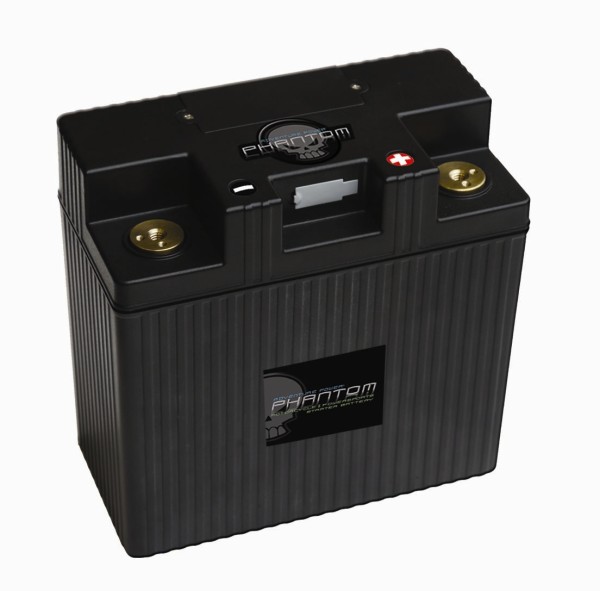 Power Storage: high capacity, low weight. Lithium Polymer batteries provide a lot of power for much less weight than say a deep cycle car battery. But the lead battery isn’t a bad low cost choice when transportation isn’t by hand or on your back. My original batteries were Lithium Ion batteries intended for use with CPAP machines, my latest battery is Lithium Polymer and was built to replace a motorcycle battery (update October 2017 this battery “works” but its capacity is about half what I get from the others mentioned next). I’ve used the CPAP batteries a lot, and found that the 222 model was good for two or three nights, and the 150 model was good for two nights. Similar to this more recent version. You probably won’t get the full amp hour rating from a battery. I find that at lower charge levels the CPAP machine won’t start running. It will spin up and then turn off repeatedly, it needs more amperage to start up. One other thing to be aware of, if you spike the voltage going into these CPAP batteries they have a protection circuit that needs a really steady 12V current to reset. That can be really frustrating when you are days from real power. That can happen if your charge controller gets too much voltage from your panel. This has only happened to me one time, and it was in super bright hot sun near the end of a charging cycle. My controller is actually just a little underrated for the panel, so in these conditions I’ve taken to covering a small percentage of the surface. That’s easy given its foldable nature.
Power Storage: high capacity, low weight. Lithium Polymer batteries provide a lot of power for much less weight than say a deep cycle car battery. But the lead battery isn’t a bad low cost choice when transportation isn’t by hand or on your back. My original batteries were Lithium Ion batteries intended for use with CPAP machines, my latest battery is Lithium Polymer and was built to replace a motorcycle battery (update October 2017 this battery “works” but its capacity is about half what I get from the others mentioned next). I’ve used the CPAP batteries a lot, and found that the 222 model was good for two or three nights, and the 150 model was good for two nights. Similar to this more recent version. You probably won’t get the full amp hour rating from a battery. I find that at lower charge levels the CPAP machine won’t start running. It will spin up and then turn off repeatedly, it needs more amperage to start up. One other thing to be aware of, if you spike the voltage going into these CPAP batteries they have a protection circuit that needs a really steady 12V current to reset. That can be really frustrating when you are days from real power. That can happen if your charge controller gets too much voltage from your panel. This has only happened to me one time, and it was in super bright hot sun near the end of a charging cycle. My controller is actually just a little underrated for the panel, so in these conditions I’ve taken to covering a small percentage of the surface. That’s easy given its foldable nature.
Solar Panel: Lightweight, Portable, durable. I got into this game pretty early, there are a lot of choices on the market today. The thing to pay attention to with solar is how much sun you think you’ll get. If you are going to be out in a forest in the winter in the north, you can leave the solar at home, pack another battery if you need it. If you are going to be in the southwest in the summer, well, maybe a little charger will be fine. I have a Brunton Solaris 62 watt flexible folding panel (discontinued by Brunton), probably too much for what I need, but I expect the panel to be operating a low efficiency a lot of the time due to clouds, trees and short days. Since the panel is flexible, I’ve also rounded up a couple of flexible tent poles to make it freestanding.
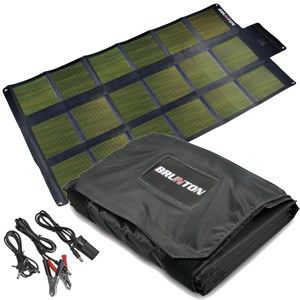 Solar Charge Controller: Portable, rugged, right for the task. The charge controller’s job is to charge the battery efficiently and safely. The panel produces power at varied voltages depending on how much light it gets. The charge controller levels this off, and may use other technology like pulse wave modulation to help get the most of lower voltages. It also cuts off the charge when the battery is full. I am using a SunGuard charge controller. It is actually rated at 4.5 amps max, but my panel will output 5.2 amps maximum. So in good bright sun I just fold over the bottom of the panel. You’ll want the charge controller to be at the same temperature as your battery, so probably both of them in the shade, because charge controller’s often take temperature into consideration when setting the charge voltage. You might want to purchase the controller and panel together, so that you are certain that they are a matched set.
Solar Charge Controller: Portable, rugged, right for the task. The charge controller’s job is to charge the battery efficiently and safely. The panel produces power at varied voltages depending on how much light it gets. The charge controller levels this off, and may use other technology like pulse wave modulation to help get the most of lower voltages. It also cuts off the charge when the battery is full. I am using a SunGuard charge controller. It is actually rated at 4.5 amps max, but my panel will output 5.2 amps maximum. So in good bright sun I just fold over the bottom of the panel. You’ll want the charge controller to be at the same temperature as your battery, so probably both of them in the shade, because charge controller’s often take temperature into consideration when setting the charge voltage. You might want to purchase the controller and panel together, so that you are certain that they are a matched set.
Voltmeter. Pretty much any voltmeter will do, but you do need to know how to use it to read voltage. As a battery gets full it’s voltage reads higher. Charge your battery on a normal charger at home until it is full, then check the voltage. During your solar charging, stop when you get near but not over this voltage. As you run the battery down, check the voltage change to see where it falls. This will let you predict how much charge you have left. I find that there comes a time when the battery has some charge left, but the CPAP machine can’t get enough amperage to get started running. If it were already running it might continue, but it seems it needs more initially.
Put it all together. Before you head out with your kit, sleep with it at home. Track how long you use it, and record the voltage before and after each use. You’ll want to see how many nights you get from a single charge. Hopefully you can avoid field recharging on all but the longest expeditions.
When you get to camp, If you are just using batteries, it is pretty straightforward. Plug things together and get some sleep. If the air is humid, you may get some condensation in the tube. You want to keep this away from the CPAP machine. So put something handy under the machine to raise it up a bit, this way the moisture will stay in the tube. When you get up, unhook the tube and get rid of any liquid water in the tube.
If you need to charge batteries with solar you are going to want to put some time into your schedule to hang out around camp and keep the panel pointed at the sun. I used a couple of tent poles to make a free standing frame, but if it gets windy it won’t stay put. I’ve draped the panel over my pack in the canoe or raft while on flat water, I put the battery and charge controller in a dry bag and seal it up with the cord coming out, not a perfect seal but keeps splashing from being a problem. Lithium batteries are okay being recharged when not entirely discharged, so take any opportunity to fill it up, and don’t worry if you don’t get to a full charge. Just use the info you have collected from home use and the voltmeter to ensure that you are ahead on charge.
So, don’t let the CPAP keep you home. Be safe and don’t go without good sleep. If you have this kind of kit handy, keep it around for power outages and in case something goes wrong with the primary power in your travel unit. Have fun!
